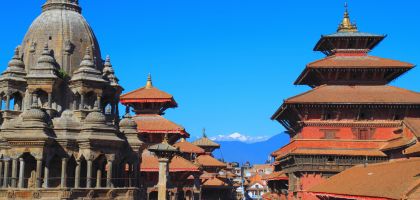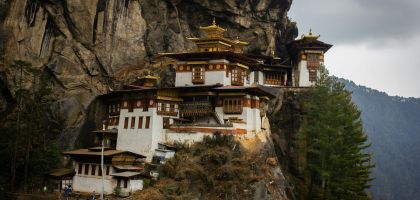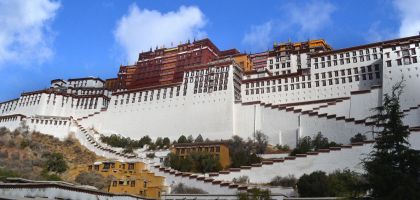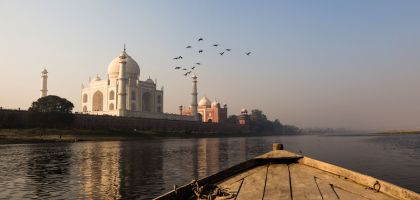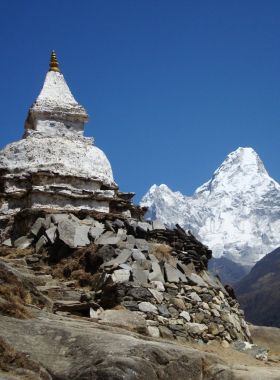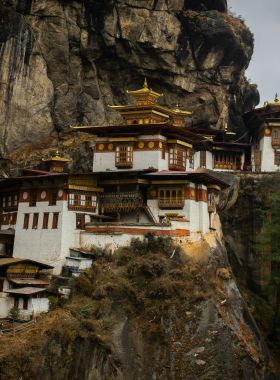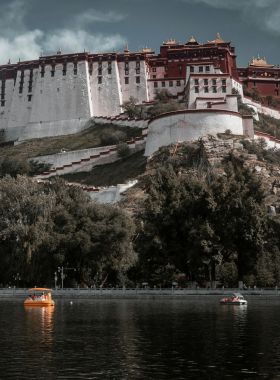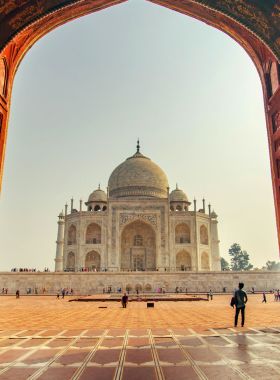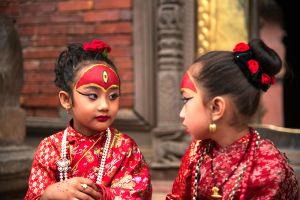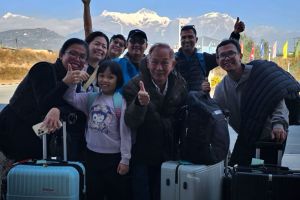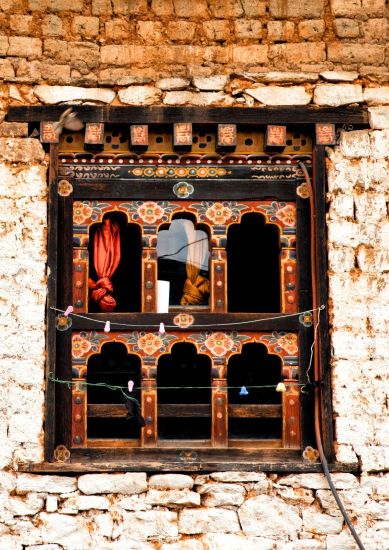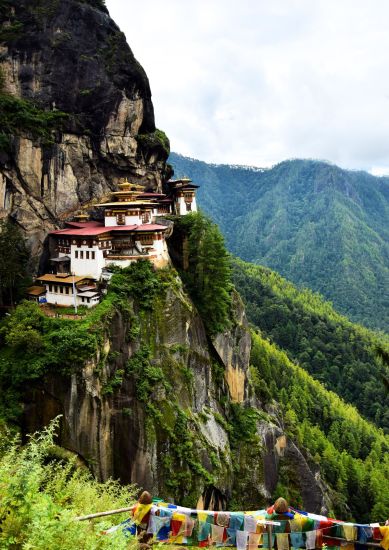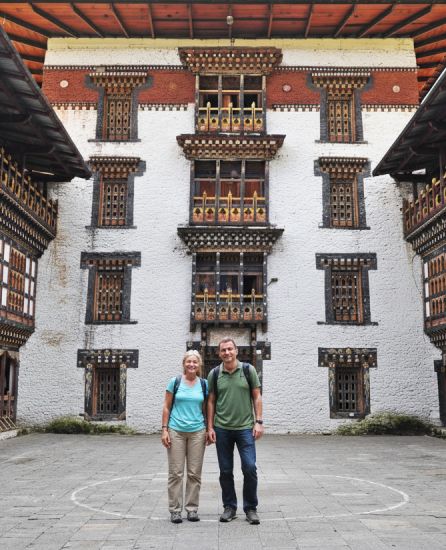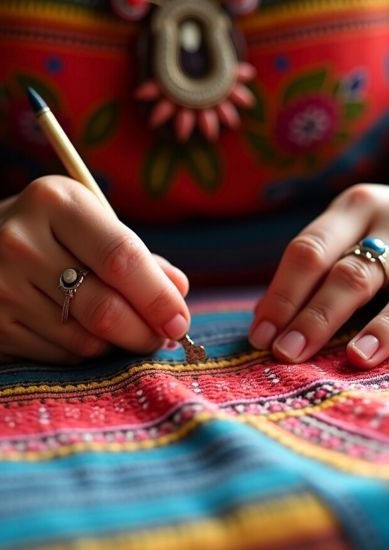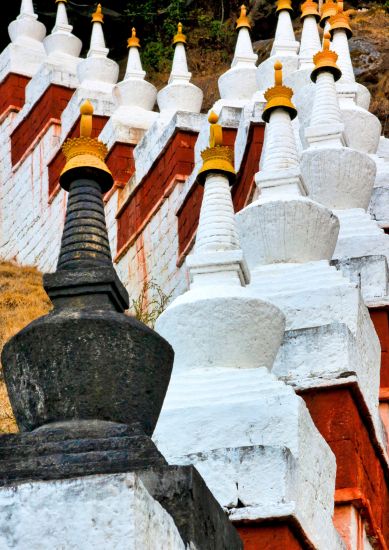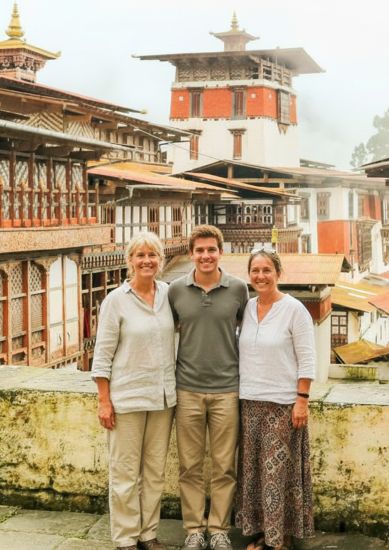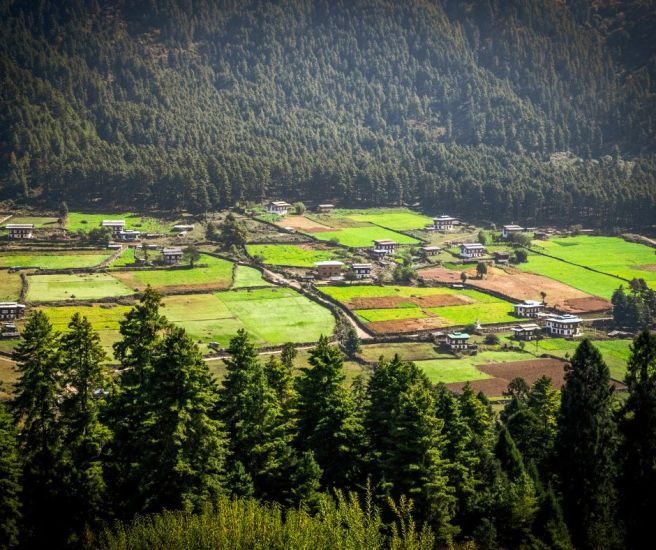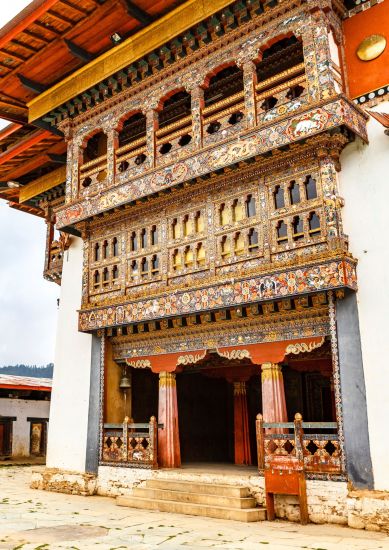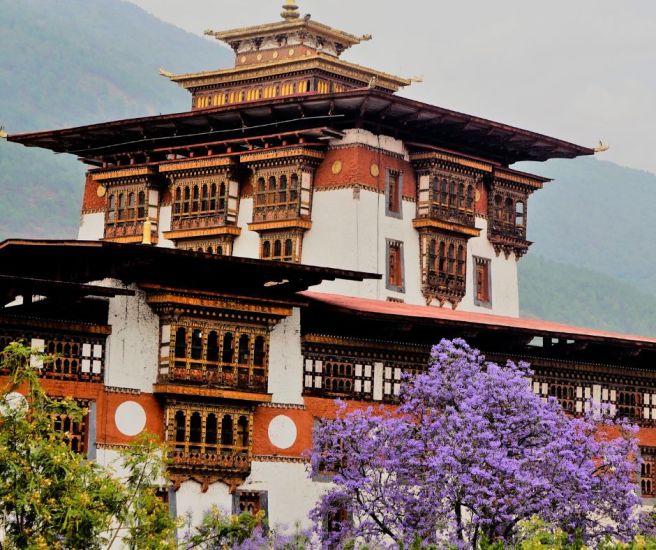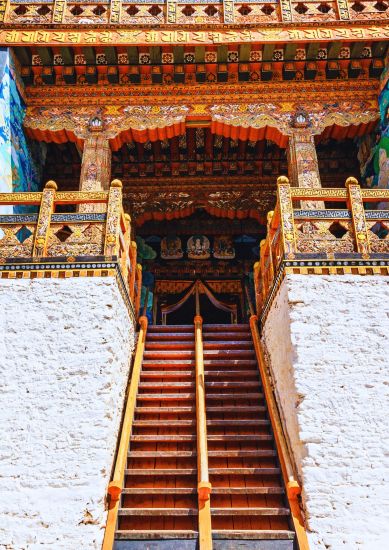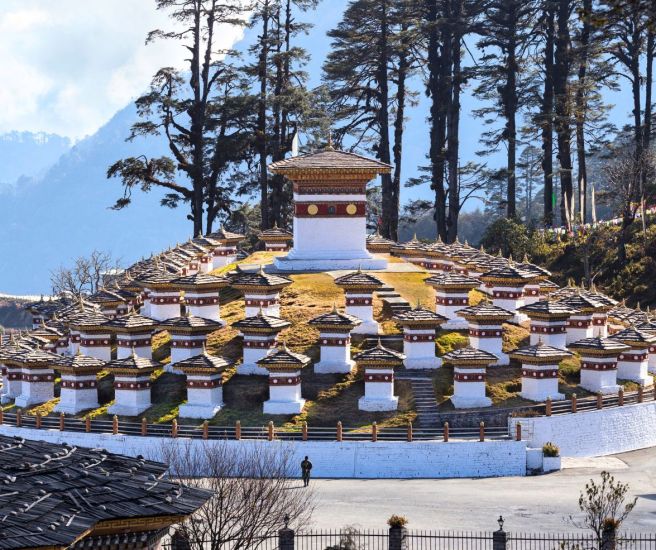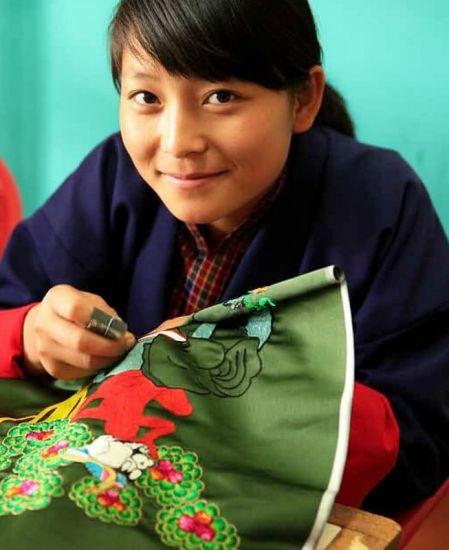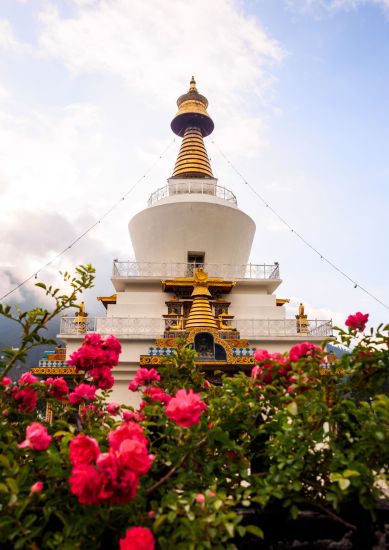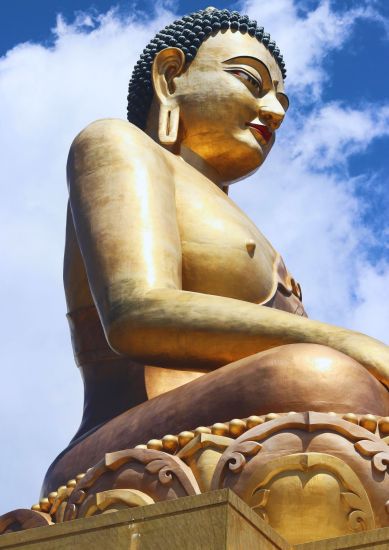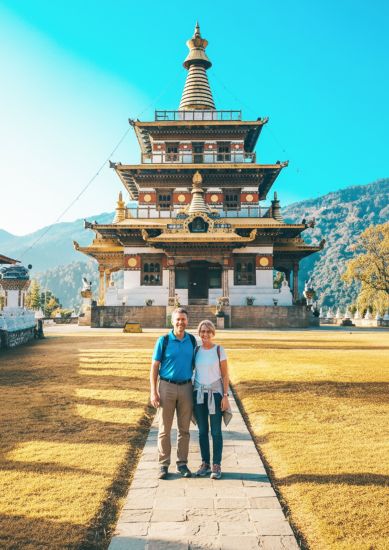Bhutan Travel – West to East
16 Days / Bhutan
Activity
Difficulty Level
Destinations
Trip Start / End
Max Altitude
Accommodation
Travel Style
Best time to travel
Personalized Travel Advice

Dev Raj Nepal
+977 9851096523
Personalized Travel Advice

Dev Raj Nepal
+977 9851096523
Detailed Itinerary
01
DAY
01
As your flight descends into Paro, the emerald valleys and snow-dusted peaks of Bhutan unfold beneath you, a breathtaking introduction to the Land of the Thunder Dragon and the beginning of your Bhutan travel adventure. Upon arrival, you’ll be greeted with warm Bhutanese hospitality and transferred to your hotel for a well-deserved rest. Later in the afternoon, take a gentle stroll through Paro town, where traditional wooden facades, fluttering prayer flags, and the crisp mountain air offer a perfect first taste of Bhutan’s timeless charm.
Arrival – Paro
As your flight descends into Paro, the emerald valleys and snow-dusted peaks of Bhutan unfold beneath you, a breathtaking introduction to the Land of the Thunder Dragon and the beginning of your Bhutan travel adventure. Upon arrival, you’ll be greeted with warm Bhutanese hospitality and transferred to your hotel for a well-deserved rest. Later in the afternoon, take a gentle stroll through Paro town, where traditional wooden facades, fluttering prayer flags, and the crisp mountain air offer a perfect first taste of Bhutan’s timeless charm.
02
DAY
02
Begin your day with a visit to Rinpung Dzong, a majestic fortress‑monastery rising above the Paro Valley. Admire its whitewashed walls, sloping roofs, and intricate woodwork, and explore its courtyards, temples, and chapels adorned with religious paintings and carvings. Constructed in 1644-46 under Zhabdrung Ngawang Namgyal, this dzong is both spiritual stronghold and administrative seat for Paro.
Next, head to Ta Dzong, perched above the dzong, which now houses the National Museum of Bhutan. Here, a rich collection of thangkas, ancient artifacts, and folk arts tells the story of Bhutan’s history, religion, and culture. Originally built in 1649 as a watchtower, Ta Dzong was transformed in 1968 into the National Museum of Bhutan. You’ll find here over 3,000 items that chronicle over 1,500 years of Bhutanese culture, religious artifacts, thangkas, ancient arms, folk arts, and even natural history collections.
In the afternoon, visit Kyichu Lhakhang, one of Bhutan’s oldest temples, where you can observe devotees performing rituals, spinning prayer wheels, and offering prayers, a serene glimpse into the spiritual heart of Bhutan. The temple houses ancient relics, an altar dedicated to Guru Rinpoche, and nearby the Guru Lhakhang with its striking statue of Guru Rinpoche holding a bow and floral arrow. Rituals here are very much part of everyday temple life: lighting butter lamps, spinning prayer wheels, offering incense and water bowls, and circumambulating chortens.
Paro Valley Exploration
Begin your day with a visit to Rinpung Dzong, a majestic fortress‑monastery rising above the Paro Valley. Admire its whitewashed walls, sloping roofs, and intricate woodwork, and explore its courtyards, temples, and chapels adorned with religious paintings and carvings. Constructed in 1644-46 under Zhabdrung Ngawang Namgyal, this dzong is both spiritual stronghold and administrative seat for Paro.
Next, head to Ta Dzong, perched above the dzong, which now houses the National Museum of Bhutan. Here, a rich collection of thangkas, ancient artifacts, and folk arts tells the story of Bhutan’s history, religion, and culture. Originally built in 1649 as a watchtower, Ta Dzong was transformed in 1968 into the National Museum of Bhutan. You’ll find here over 3,000 items that chronicle over 1,500 years of Bhutanese culture, religious artifacts, thangkas, ancient arms, folk arts, and even natural history collections.
In the afternoon, visit Kyichu Lhakhang, one of Bhutan’s oldest temples, where you can observe devotees performing rituals, spinning prayer wheels, and offering prayers, a serene glimpse into the spiritual heart of Bhutan. The temple houses ancient relics, an altar dedicated to Guru Rinpoche, and nearby the Guru Lhakhang with its striking statue of Guru Rinpoche holding a bow and floral arrow. Rituals here are very much part of everyday temple life: lighting butter lamps, spinning prayer wheels, offering incense and water bowls, and circumambulating chortens.
03
DAY
03
Start your day with a short drive from Paro to the trailhead at Taktsang, the starting point for the famous Tiger’s Nest Monastery hike. The trail winds through pine forests, past waterfalls, and offers panoramic views of the Paro Valley as you ascend to the monastery perched dramatically on a cliffside 900 meters above. The round-trip trek takes approximately 4–5 hours, allowing time to pause, admire the architecture, and soak in the spiritual atmosphere.
After descending, return to Paro for lunch. On the drive to Thimphu, make a stop at the Tachogang Lhakhang Bridge, a historic iron chain bridge leading to Tachogang Lhakhang temple. Built centuries ago by Thangtong Gyalpo, a famous Kagyu master, this site combines engineering marvel with serene temple surroundings.
Continue your Bhutan travel as you drive to Thimphu, Bhutan’s bustling capital. After reaching Thimphu, spend the evening at leisure, exploring the city’s mix of tradition and modernity, or simply relaxing and enjoying views of the surrounding hills.
Hike to Tiger’s Nest & Drive to Thimphu
Start your day with a short drive from Paro to the trailhead at Taktsang, the starting point for the famous Tiger’s Nest Monastery hike. The trail winds through pine forests, past waterfalls, and offers panoramic views of the Paro Valley as you ascend to the monastery perched dramatically on a cliffside 900 meters above. The round-trip trek takes approximately 4–5 hours, allowing time to pause, admire the architecture, and soak in the spiritual atmosphere.
After descending, return to Paro for lunch. On the drive to Thimphu, make a stop at the Tachogang Lhakhang Bridge, a historic iron chain bridge leading to Tachogang Lhakhang temple. Built centuries ago by Thangtong Gyalpo, a famous Kagyu master, this site combines engineering marvel with serene temple surroundings.
Continue your Bhutan travel as you drive to Thimphu, Bhutan’s bustling capital. After reaching Thimphu, spend the evening at leisure, exploring the city’s mix of tradition and modernity, or simply relaxing and enjoying views of the surrounding hills.
04
DAY
04
Explore Thimphu this day, the vibrant capital of Bhutan, where tradition and modernity exist in perfect harmony. First, visit the National Memorial Chorten, an iconic white stupa crowned with a golden spire, built in memory of the Third King, Jigme Dorji Wangchuck. Dedicated to world peace, this spiritual landmark is a place where locals gather to circumambulate in prayer, surrounded by exquisite Buddhist architecture, intricate paintings, and sculptures symbolizing the “Mind of Buddha.”
Continue to Buddha Point, home to the towering Buddha Dordenma Statue, one of the largest in the world, gazing peacefully over the Thimphu valley as a symbol of happiness and serenity.
Next, visit Changangkha Lhakhang, a 12th-century fortress-like temple perched on a ridge, revered for blessings, especially for newborns, and offering sweeping views of the city.
Enjoy a traditional Bhutanese lunch at a local restaurant before heading to the National Institute for Zorig Chusum, also known as the School of 13 Traditional Arts and Crafts. Established in 1971, this unique institute is dedicated to preserving Bhutan’s traditional arts such as painting, sculpting, wood carving, paper making, masonry, weaving, embroidery, and more.
Following this, visit the Textile Museum, where you will discover Bhutan’s vibrant textile traditions, renowned for their intricate patterns and vibrant colors. The museum exhibits traditional weaving techniques and showcases garments that highlight Bhutanese identity and craftsmanship, offering an exceptional appreciation of this living art form.
In the late afternoon, visit the market area of Thimphu and also walk around the famous Crafts Bazar on a shopping tour. You can buy various handicrafts and textiles completely crafted from locally sourced products in Bhutan and which reflect the rich heritage of Bhutan.
In the evening, visit the magnificent Tashichho Dzong, a grand fortress and monastery that serves as the seat of Bhutan’s government and the summer residence of the Chief Abbot. With its whitewashed walls, gilded roofs, and intricate woodwork, the dzong stands as a masterpiece of Bhutanese architecture and a venue for the vibrant Thimphu Tshechu festival.
This full-day journey weaves together spirituality, culture, wildlife, and history, offering a truly immersive introduction to Bhutan’s capital.
Thimphu Exploration
Explore Thimphu this day, the vibrant capital of Bhutan, where tradition and modernity exist in perfect harmony. First, visit the National Memorial Chorten, an iconic white stupa crowned with a golden spire, built in memory of the Third King, Jigme Dorji Wangchuck. Dedicated to world peace, this spiritual landmark is a place where locals gather to circumambulate in prayer, surrounded by exquisite Buddhist architecture, intricate paintings, and sculptures symbolizing the “Mind of Buddha.”
Continue to Buddha Point, home to the towering Buddha Dordenma Statue, one of the largest in the world, gazing peacefully over the Thimphu valley as a symbol of happiness and serenity.
Next, visit Changangkha Lhakhang, a 12th-century fortress-like temple perched on a ridge, revered for blessings, especially for newborns, and offering sweeping views of the city.
Enjoy a traditional Bhutanese lunch at a local restaurant before heading to the National Institute for Zorig Chusum, also known as the School of 13 Traditional Arts and Crafts. Established in 1971, this unique institute is dedicated to preserving Bhutan’s traditional arts such as painting, sculpting, wood carving, paper making, masonry, weaving, embroidery, and more.
Following this, visit the Textile Museum, where you will discover Bhutan’s vibrant textile traditions, renowned for their intricate patterns and vibrant colors. The museum exhibits traditional weaving techniques and showcases garments that highlight Bhutanese identity and craftsmanship, offering an exceptional appreciation of this living art form.
In the late afternoon, visit the market area of Thimphu and also walk around the famous Crafts Bazar on a shopping tour. You can buy various handicrafts and textiles completely crafted from locally sourced products in Bhutan and which reflect the rich heritage of Bhutan.
In the evening, visit the magnificent Tashichho Dzong, a grand fortress and monastery that serves as the seat of Bhutan’s government and the summer residence of the Chief Abbot. With its whitewashed walls, gilded roofs, and intricate woodwork, the dzong stands as a masterpiece of Bhutanese architecture and a venue for the vibrant Thimphu Tshechu festival.
This full-day journey weaves together spirituality, culture, wildlife, and history, offering a truly immersive introduction to Bhutan’s capital.
05
DAY
05
Following breakfast, continue your Bhutan travel as you take a scenic drive from Thimphu to Punakha, traversing the picturesque Dochula Pass at 3,100 meters. At the pass, pause to admire the 108 Druk Wangyal Chortens, memorial stupas constructed in 2004 under the patronage of Queen Ashi Dorji Wangmo Wangchuck. These chortens honor Bhutanese soldiers who lost their lives in a 2003 military operation against insurgents. The site offers panoramic views of the eastern Himalayas and features the Druk Wangyal Lhakhang, a temple built to commemorate 100 years of the monarchy, adorned with murals blending traditional and modern themes.
Continuing your tour, see the famed Punakha Dzong, the second oldest and largest dzong in Bhutan, constructed in 1637–38 by Zhabdrung Ngawang Namgyal. Situated at the confluence of the Pho Chhu and Mo Chhu rivers, the dzong served as the administrative and religious center of Bhutan until the mid-1950s. It houses sacred relics and has been the site of significant events, including the coronation of the first King of Bhutan in 1907.
In the afternoon, proceed towards the village of Sopsokha, from where you can reach Chimi Lhakhang, the famous “Fertility Temple,” with a gentle and scenic walk. The trail is about 1.5 kilometers one way and typically takes 20 to 30 minutes at a moderate pace. The path leads through lush paddy fields, gentle slopes, and traditional houses of Sopsokha village, many decorated with phallic symbols, a homage to the temple’s unique history. The walk is mostly flat, with only a mild ascent near the end as you approach the small hill where the temple sits.
Founded by the colorful saint Drukpa Kunley, Chimi Lhakhang exudes a light-hearted yet sacred atmosphere. Its whimsical artwork and phallic symbols reflect Bhutanese humor and spirituality, making it a truly unique cultural landmark. Return to Punakha in the later afternoon and explore the surrounding region.
Thimphu – Punakha
Following breakfast, continue your Bhutan travel as you take a scenic drive from Thimphu to Punakha, traversing the picturesque Dochula Pass at 3,100 meters. At the pass, pause to admire the 108 Druk Wangyal Chortens, memorial stupas constructed in 2004 under the patronage of Queen Ashi Dorji Wangmo Wangchuck. These chortens honor Bhutanese soldiers who lost their lives in a 2003 military operation against insurgents. The site offers panoramic views of the eastern Himalayas and features the Druk Wangyal Lhakhang, a temple built to commemorate 100 years of the monarchy, adorned with murals blending traditional and modern themes.
Continuing your tour, see the famed Punakha Dzong, the second oldest and largest dzong in Bhutan, constructed in 1637–38 by Zhabdrung Ngawang Namgyal. Situated at the confluence of the Pho Chhu and Mo Chhu rivers, the dzong served as the administrative and religious center of Bhutan until the mid-1950s. It houses sacred relics and has been the site of significant events, including the coronation of the first King of Bhutan in 1907.
In the afternoon, proceed towards the village of Sopsokha, from where you can reach Chimi Lhakhang, the famous “Fertility Temple,” with a gentle and scenic walk. The trail is about 1.5 kilometers one way and typically takes 20 to 30 minutes at a moderate pace. The path leads through lush paddy fields, gentle slopes, and traditional houses of Sopsokha village, many decorated with phallic symbols, a homage to the temple’s unique history. The walk is mostly flat, with only a mild ascent near the end as you approach the small hill where the temple sits.
Founded by the colorful saint Drukpa Kunley, Chimi Lhakhang exudes a light-hearted yet sacred atmosphere. Its whimsical artwork and phallic symbols reflect Bhutanese humor and spirituality, making it a truly unique cultural landmark. Return to Punakha in the later afternoon and explore the surrounding region.
06
DAY
06
After breakfast, set out from Punakha and begin the journey toward the tranquil Phobjikha Valley. The drive winds through gently rolling hills, terraced fields, and pine-clad mountains, offering glimpses of traditional Bhutanese villages along the way. As you ascend toward the higher altitudes, the road passes through forests of blue pine and fir, with occasional waterfalls cascading down the slopes and small streams sparkling in the sunlight.
En route, stop at Gangtey Monastery, the principal monastery of the Nyingmapa sect, which crowns a ridge overlooking the valley. Take in the panoramic views of the Phobjikha Valley spread below, with its patchwork of marshlands, meadows, and farmsteads. Continue down into the valley, famed as the winter home of the rare black-necked cranes, which grace the skies between November and March.
Upon arrival, stroll through the serene surroundings, and experience the quiet pace of rural Bhutanese life, framed by the majestic peaks that cradle this hidden Himalayan gem.
Punakha – Phobjikha Valley
After breakfast, set out from Punakha and begin the journey toward the tranquil Phobjikha Valley. The drive winds through gently rolling hills, terraced fields, and pine-clad mountains, offering glimpses of traditional Bhutanese villages along the way. As you ascend toward the higher altitudes, the road passes through forests of blue pine and fir, with occasional waterfalls cascading down the slopes and small streams sparkling in the sunlight.
En route, stop at Gangtey Monastery, the principal monastery of the Nyingmapa sect, which crowns a ridge overlooking the valley. Take in the panoramic views of the Phobjikha Valley spread below, with its patchwork of marshlands, meadows, and farmsteads. Continue down into the valley, famed as the winter home of the rare black-necked cranes, which grace the skies between November and March.
Upon arrival, stroll through the serene surroundings, and experience the quiet pace of rural Bhutanese life, framed by the majestic peaks that cradle this hidden Himalayan gem.
07
DAY
07
Embark on a serene morning walk along the Gangtey Nature Trail, a 4 km loop that meanders through the heart of the Phobjikha Valley. Starting from the Gangtey Monastery, the trail gently descends through lush pine forests and vibrant rhododendron groves, offering panoramic views of the valley below. As you walk, you’ll pass traditional Bhutanese farmhouses and cross small streams, immersing yourself in the tranquil rural landscape. The trail is particularly renowned for its birdwatching opportunities; during the winter months, it serves as a habitat for the endangered black-necked cranes, which migrate from the Tibetan Plateau. In addition to these majestic birds, you might also spot red-billed choughs and Himalayan griffon vultures soaring overhead. The hike concludes at Khewa Lhakhang, a small temple nestled in the valley, where you can reflect on the journey and the surrounding natural beauty.
After the walk, take time to visit nearby villages, where you can interact with local communities and gain insight into traditional Bhutanese life. This day offers a perfect blend of nature, culture, and tranquility in one of Bhutan’s most picturesque valleys.
Phobjikha Exploration
Embark on a serene morning walk along the Gangtey Nature Trail, a 4 km loop that meanders through the heart of the Phobjikha Valley. Starting from the Gangtey Monastery, the trail gently descends through lush pine forests and vibrant rhododendron groves, offering panoramic views of the valley below. As you walk, you’ll pass traditional Bhutanese farmhouses and cross small streams, immersing yourself in the tranquil rural landscape. The trail is particularly renowned for its birdwatching opportunities; during the winter months, it serves as a habitat for the endangered black-necked cranes, which migrate from the Tibetan Plateau. In addition to these majestic birds, you might also spot red-billed choughs and Himalayan griffon vultures soaring overhead. The hike concludes at Khewa Lhakhang, a small temple nestled in the valley, where you can reflect on the journey and the surrounding natural beauty.
After the walk, take time to visit nearby villages, where you can interact with local communities and gain insight into traditional Bhutanese life. This day offers a perfect blend of nature, culture, and tranquility in one of Bhutan’s most picturesque valleys.
08
DAY
08
Today, we take a scenic drive towards Bumthang, one of the most beautiful and culturally rich regions in Bhutan, offering a quintessential Bhutan travel experience. The journey is filled with stunning landscapes and historical sights. Our first stop along the way is the Chendebji Chorten, a prominent stupa built in the 18th century, located near the village of Chendebji. This serene spot is a perfect place to stretch your legs while taking in the peaceful surroundings.
Continuing our drive, we’ll pass through the picturesque village of Trongsa and its impressive Trongsa Dzong, perched dramatically on a ridge above the town. A visit to the Royal Heritage Museum in Trongsa provides fascinating insights into Bhutan’s royal history, offering an educational break during our Bhutan travel adventure.
Lunch will be served at the tranquil Willing Falls, a delightful spot perfect for a relaxing break amidst the journey. After lunch, we continue our drive towards Bumthang, arriving in the evening. We arrive at our hotel in Bumthang, where you can unwind and prepare for another day of exploring the region.
Optional Hot Stone Bath: You can experience a traditional Hot Stone Bath with advance notice. Hot stone bath is purely a Bhutanese traditional method of curing skin ailments, joint pains, hypertension, stomach disorders, arthritis, and many other minor diseases. Even if you don’t have any of these issues, after a laborious hike of the day, you will feel relaxation from the hot stone bath. Pre-booking is a requirement.
Phobjikha to Bumthang
Today, we take a scenic drive towards Bumthang, one of the most beautiful and culturally rich regions in Bhutan, offering a quintessential Bhutan travel experience. The journey is filled with stunning landscapes and historical sights. Our first stop along the way is the Chendebji Chorten, a prominent stupa built in the 18th century, located near the village of Chendebji. This serene spot is a perfect place to stretch your legs while taking in the peaceful surroundings.
Continuing our drive, we’ll pass through the picturesque village of Trongsa and its impressive Trongsa Dzong, perched dramatically on a ridge above the town. A visit to the Royal Heritage Museum in Trongsa provides fascinating insights into Bhutan’s royal history, offering an educational break during our Bhutan travel adventure.
Lunch will be served at the tranquil Willing Falls, a delightful spot perfect for a relaxing break amidst the journey. After lunch, we continue our drive towards Bumthang, arriving in the evening. We arrive at our hotel in Bumthang, where you can unwind and prepare for another day of exploring the region.
Optional Hot Stone Bath: You can experience a traditional Hot Stone Bath with advance notice. Hot stone bath is purely a Bhutanese traditional method of curing skin ailments, joint pains, hypertension, stomach disorders, arthritis, and many other minor diseases. Even if you don’t have any of these issues, after a laborious hike of the day, you will feel relaxation from the hot stone bath. Pre-booking is a requirement.
09
DAY
09
After a hearty breakfast, we begin our day in Bumthang with a walking tour to visit three of the region’s most revered temples: Jambay Lhakhang, Kurjey Lhakhang, and Tamshing Lhakhang. These temples are rich in history and spirituality, offering insight into Bhutanese Buddhist traditions. Jambay Lhakhang, built in the 7th century by the Tibetan King Songtsen Gampo, is an iconic pilgrimage site. Kurjey Lhakhang, with its beautiful architecture, houses the rock imprint of Guru Rinpoche, who meditated here. Tamshing Lhakhang, founded by the famous Lama Pema Lingpa, is an important center for spiritual learning and known for its sacred murals. The walk between these temples takes you through beautiful landscapes, offering a chance to enjoy the peaceful surroundings of Bumthang.
In the afternoon, we’ll visit the Dorjibi Weaving Centre, where you can witness the intricate art of traditional Bhutanese weaving. The center is famous for producing beautiful textiles, including handwoven fabrics and garments, showcasing the skilled craftsmanship of the locals. It’s an excellent opportunity to learn about the significance of weaving in Bhutanese culture and purchase some unique souvenirs. Overnight in Bumthang.
Bumthang Exploration
After a hearty breakfast, we begin our day in Bumthang with a walking tour to visit three of the region’s most revered temples: Jambay Lhakhang, Kurjey Lhakhang, and Tamshing Lhakhang. These temples are rich in history and spirituality, offering insight into Bhutanese Buddhist traditions. Jambay Lhakhang, built in the 7th century by the Tibetan King Songtsen Gampo, is an iconic pilgrimage site. Kurjey Lhakhang, with its beautiful architecture, houses the rock imprint of Guru Rinpoche, who meditated here. Tamshing Lhakhang, founded by the famous Lama Pema Lingpa, is an important center for spiritual learning and known for its sacred murals. The walk between these temples takes you through beautiful landscapes, offering a chance to enjoy the peaceful surroundings of Bumthang.
In the afternoon, we’ll visit the Dorjibi Weaving Centre, where you can witness the intricate art of traditional Bhutanese weaving. The center is famous for producing beautiful textiles, including handwoven fabrics and garments, showcasing the skilled craftsmanship of the locals. It’s an excellent opportunity to learn about the significance of weaving in Bhutanese culture and purchase some unique souvenirs. Overnight in Bumthang.
10
DAY
10
Embark on a scenic drive from Bumthang to Mongar, traversing the Thrumshing La Pass, Bhutan’s second-highest motorable pass at 3,780 meters. On clear days, the pass offers breathtaking views of the Eastern Himalayan range, including glimpses of Gangkar Phuensum, Bhutan’s highest peak. The landscape transitions dramatically from alpine forests to subtropical valleys as you descend, showcasing Bhutan’s diverse topography.
En route, visit the traditional village of Ura, situated at an elevation of 3,100 meters. Our guide will explain the significance of Ura as a center for Buddhist heritage and culture. You will also be guided towards the heart of the village to see the revered Ura Lhakhang, a two-storey temple dedicated to Guru Rinpoche, housing a large bronze statue and serving as a spiritual center for the community. The village also features ongoing efforts to construct Bhutan’s tallest pagoda, reflecting its dedication to preserving cultural traditions.
Arrive in Mongar, a charming town known for its strategic location on the eastern Bhutan highway and surrounded by lush forests and terraced hills. Mongar offers a peaceful atmosphere and a glimpse into daily life in eastern Bhutan, making it a perfect place to relax after a day of scenic driving and cultural exploration.
Bumthang – Mongar
Embark on a scenic drive from Bumthang to Mongar, traversing the Thrumshing La Pass, Bhutan’s second-highest motorable pass at 3,780 meters. On clear days, the pass offers breathtaking views of the Eastern Himalayan range, including glimpses of Gangkar Phuensum, Bhutan’s highest peak. The landscape transitions dramatically from alpine forests to subtropical valleys as you descend, showcasing Bhutan’s diverse topography.
En route, visit the traditional village of Ura, situated at an elevation of 3,100 meters. Our guide will explain the significance of Ura as a center for Buddhist heritage and culture. You will also be guided towards the heart of the village to see the revered Ura Lhakhang, a two-storey temple dedicated to Guru Rinpoche, housing a large bronze statue and serving as a spiritual center for the community. The village also features ongoing efforts to construct Bhutan’s tallest pagoda, reflecting its dedication to preserving cultural traditions.
Arrive in Mongar, a charming town known for its strategic location on the eastern Bhutan highway and surrounded by lush forests and terraced hills. Mongar offers a peaceful atmosphere and a glimpse into daily life in eastern Bhutan, making it a perfect place to relax after a day of scenic driving and cultural exploration.
11
DAY
11
Today, we take a scenic drive from Mongar to Trashiyangtse, approximately 3-4 hours, traversing the picturesque landscapes of eastern Bhutan. En route, pass through traditional villages, offering glimpses into rural Bhutanese life. Upon arrival in Trashiyangtse, explore the Trashiyangtse Dzong, a fortress-monastery that serves as the administrative and religious center of the district. The dzong’s architecture reflects traditional Bhutanese styles and offers panoramic views of the surrounding valley. The fortress with origins dating back to the 9th century and rebuilt in the 15th century by the famed Bhutanese treasure revealer Pema Lingpa. The dzong houses statues of Avalokiteshvara (Chuchizhey), Guru Rinpoche, Buddha, and other deities, and carries a rich legend and profound spiritual significance.
Visit the School of 13 Traditional Arts (Rigney School), a sister school of Zorig Chosum in Thimphu, which teaches six Bhutanese art forms including painting, pottery, wood sculpture, wood-turning, lacquer-work, and embroidery. Engage with master artisans such as the Shagzopa woodturners, known for crafting intricate wooden bowls (Dhapa) and other traditional items, gaining insight into skills that preserve Bhutan’s artistic heritage and support local livelihoods.
Mongar – Trashiyangtse
Today, we take a scenic drive from Mongar to Trashiyangtse, approximately 3-4 hours, traversing the picturesque landscapes of eastern Bhutan. En route, pass through traditional villages, offering glimpses into rural Bhutanese life. Upon arrival in Trashiyangtse, explore the Trashiyangtse Dzong, a fortress-monastery that serves as the administrative and religious center of the district. The dzong’s architecture reflects traditional Bhutanese styles and offers panoramic views of the surrounding valley. The fortress with origins dating back to the 9th century and rebuilt in the 15th century by the famed Bhutanese treasure revealer Pema Lingpa. The dzong houses statues of Avalokiteshvara (Chuchizhey), Guru Rinpoche, Buddha, and other deities, and carries a rich legend and profound spiritual significance.
Visit the School of 13 Traditional Arts (Rigney School), a sister school of Zorig Chosum in Thimphu, which teaches six Bhutanese art forms including painting, pottery, wood sculpture, wood-turning, lacquer-work, and embroidery. Engage with master artisans such as the Shagzopa woodturners, known for crafting intricate wooden bowls (Dhapa) and other traditional items, gaining insight into skills that preserve Bhutan’s artistic heritage and support local livelihoods.
12
DAY
12
Spend the day exploring the rich cultural and rural heritage of Trashiyangtse. Visit Wangchuck Lhakhang, a temple consecrated as a replica of Nepal’s Boudhanath Stupa by Bhutan’s 13th Chief Abbot Je Sherub Wangchuk, admired for its spiritual sanctity and intricate architecture. Head to Chorten Kora, an iconic 17th-century stupa with fascinating legends, located just minutes from the town center, and witness local devotees performing rituals.
In the afternoon, wander through the nearby villages to experience traditional rural life, unique Bhutanese architecture, and vibrant community culture. Engage with local artisans practicing crafts such as woodcarving and weaving, observing their skills and learning about the techniques that sustain local livelihoods. This day offers an immersive experience in Trashiyangtse’s spiritual, cultural, and artisanal traditions, away from the main tourist trail.
Trashiyangtse Exploration
Spend the day exploring the rich cultural and rural heritage of Trashiyangtse. Visit Wangchuck Lhakhang, a temple consecrated as a replica of Nepal’s Boudhanath Stupa by Bhutan’s 13th Chief Abbot Je Sherub Wangchuk, admired for its spiritual sanctity and intricate architecture. Head to Chorten Kora, an iconic 17th-century stupa with fascinating legends, located just minutes from the town center, and witness local devotees performing rituals.
In the afternoon, wander through the nearby villages to experience traditional rural life, unique Bhutanese architecture, and vibrant community culture. Engage with local artisans practicing crafts such as woodcarving and weaving, observing their skills and learning about the techniques that sustain local livelihoods. This day offers an immersive experience in Trashiyangtse’s spiritual, cultural, and artisanal traditions, away from the main tourist trail.
13
DAY
13
Depart Trashiyangtse in the morning for a scenic drive to Trashigang, the main town of eastern Bhutan, nestled along the banks of the Drangme Chhu River. The journey offers views of terraced fields, forested hills, and traditional villages, giving travelers a glimpse of rural life in this part of the country. Upon arrival, visit Trashigang Dzong, also called “The Fortress of the Auspicious Hill”, built in 1659 to defend against Tibetan invasions. Perched on a ledge with steep cliffs on three sides and overlooking the Drangme Chhu and Gamri Chhu rivers, the dzong occupies an imposing and scenic location. It serves religious, administrative, and military purposes, housing a monastic community alongside government offices.
Architecturally, Trashigang Dzong exemplifies traditional Bhutanese dzong style, with soaring whitewashed walls, intricate woodwork, large courtyards, red roofs, and vibrant paintings narrating Bhutan’s history and spiritual life. The fortress hosts important temples and ceremonial events, including the annual Trashigang Tshechu festival, which draws locals and visitors to witness traditional dances and religious performances. Later, take a leisurely walk around the town and the local market, where colorful stalls offer fresh produce, handicrafts, and an authentic glimpse into the community’s daily life.
Trashiyangtse – Trashigang
Depart Trashiyangtse in the morning for a scenic drive to Trashigang, the main town of eastern Bhutan, nestled along the banks of the Drangme Chhu River. The journey offers views of terraced fields, forested hills, and traditional villages, giving travelers a glimpse of rural life in this part of the country. Upon arrival, visit Trashigang Dzong, also called “The Fortress of the Auspicious Hill”, built in 1659 to defend against Tibetan invasions. Perched on a ledge with steep cliffs on three sides and overlooking the Drangme Chhu and Gamri Chhu rivers, the dzong occupies an imposing and scenic location. It serves religious, administrative, and military purposes, housing a monastic community alongside government offices.
Architecturally, Trashigang Dzong exemplifies traditional Bhutanese dzong style, with soaring whitewashed walls, intricate woodwork, large courtyards, red roofs, and vibrant paintings narrating Bhutan’s history and spiritual life. The fortress hosts important temples and ceremonial events, including the annual Trashigang Tshechu festival, which draws locals and visitors to witness traditional dances and religious performances. Later, take a leisurely walk around the town and the local market, where colorful stalls offer fresh produce, handicrafts, and an authentic glimpse into the community’s daily life.
14
DAY
14
After breakfast, depart Trashigang for a scenic drive to Samdrup Jongkhar, a journey of approximately 6 to 7 hours that takes you through the heart of eastern Bhutan. The route winds along terraced fields, forested hills, and traditional villages, offering glimpses of rural life and the dramatic landscapes of the Drangme Chhu River valley. Along the way, pass through Kanglung, home to Sherubtse College, Bhutan’s oldest and most prestigious institution of higher learning, and cross the Yongphula Pass at 2,190 meters, where panoramic views of the eastern Himalayas mark the transition from central to eastern Bhutan. Descend through towns such as Gumchu and Khaling, which showcase Bhutan’s commitment to education and community development.
Arrive in Samdrup Jongkhar, Bhutan’s southeastern border town, where the vibrant local market and a mix of Bhutanese and Indian influences offer a unique cultural atmosphere. Stroll through the town to experience daily life, observe traditional architecture, and soak in the lively ambiance, reflecting the convergence of cultures at this gateway to eastern Bhutan.
Trashigang – Samdrup Jongkhar
After breakfast, depart Trashigang for a scenic drive to Samdrup Jongkhar, a journey of approximately 6 to 7 hours that takes you through the heart of eastern Bhutan. The route winds along terraced fields, forested hills, and traditional villages, offering glimpses of rural life and the dramatic landscapes of the Drangme Chhu River valley. Along the way, pass through Kanglung, home to Sherubtse College, Bhutan’s oldest and most prestigious institution of higher learning, and cross the Yongphula Pass at 2,190 meters, where panoramic views of the eastern Himalayas mark the transition from central to eastern Bhutan. Descend through towns such as Gumchu and Khaling, which showcase Bhutan’s commitment to education and community development.
Arrive in Samdrup Jongkhar, Bhutan’s southeastern border town, where the vibrant local market and a mix of Bhutanese and Indian influences offer a unique cultural atmosphere. Stroll through the town to experience daily life, observe traditional architecture, and soak in the lively ambiance, reflecting the convergence of cultures at this gateway to eastern Bhutan.
15
DAY
15
After breakfast, depart Samdrup Jongkhar and cross the Bhutan-India border, entering the Indian state of Assam. The drive to Guwahati takes approximately 3 to 4 hours, passing through lush tea gardens, rolling hills, and small rural settlements that showcase the natural beauty of Assam. Upon arrival in Guwahati, you’ll be greeted by the bustling city atmosphere along the Brahmaputra River, with its mix of modern urban life and traditional Assamese culture. This marks the end of your Bhutan journey, as you settle into your hotel and reflect on the stunning landscapes, rich traditions, and cultural experiences you’ve enjoyed over the past two weeks.
Samdrup Jongkhar – Guwahati (India)
After breakfast, depart Samdrup Jongkhar and cross the Bhutan-India border, entering the Indian state of Assam. The drive to Guwahati takes approximately 3 to 4 hours, passing through lush tea gardens, rolling hills, and small rural settlements that showcase the natural beauty of Assam. Upon arrival in Guwahati, you’ll be greeted by the bustling city atmosphere along the Brahmaputra River, with its mix of modern urban life and traditional Assamese culture. This marks the end of your Bhutan journey, as you settle into your hotel and reflect on the stunning landscapes, rich traditions, and cultural experiences you’ve enjoyed over the past two weeks.
16
DAY
16
Today marks the conclusion of your journey. After breakfast, transfer to Guwahati Airport for your flight to Delhi. Upon arrival in Delhi, connect with your onward flight for departure.
Guwahati – New Delhi – Departure
Today marks the conclusion of your journey. After breakfast, transfer to Guwahati Airport for your flight to Delhi. Upon arrival in Delhi, connect with your onward flight for departure.
Tour Cost
At High Asia Tours, we know that understanding tour costs is essential for planning your trip. Due to variables such as accommodation choices, meal plans, transportation options, group size, and seasonal demand, providing an exact price upfront is challenging.
To assist you, we offer a starting price to give a general idea of the cost:
The starting cost for this tour is
Includes / Excludes
Inclusions
-
Accommodation on twin sharing.
-
All transfers and sightseeing as on itinerary.
-
Three meals a day.
-
English speaking local Tour Guide.
-
Sightseeing admission fee.
-
Bhutan visa fee.
Exclusions
-
Airfare to and out of Bhutan.
-
Expenses of personal nature such as drinks, tip, laundry, phone etc.
-
Extra expenses due to nature and unforeseen events.
-
Travel Insurance.
Trip Info
Bhutan Travel
Bhutan travel is an invitation to immerse yourself in a land where tradition and nature meet in perfect harmony. Nestled in the eastern Himalayas, Bhutan unfolds with emerald valleys, terraced farmlands, snow-capped peaks, and tranquil rivers. The country’s deep-rooted culture, preserved monasteries, and living traditions make every journey memorable.
The story of Bhutan travel began in 1974 when the kingdom opened its doors to international visitors. In the early years only a few hundred travelers were welcomed each year, reflecting Bhutan’s careful approach to sharing its culture and environment with the world. The government emphasized a high-value model of tourism that continues today, ensuring visitors experience the nation’s heritage and landscapes in a meaningful and sustainable way.
Traveling through Bhutan reveals a society guided by Gross National Happiness. Every step of your Bhutan journey, from visiting the cliffside Tiger’s Nest Monastery to wandering through ancient dzongs and joining vibrant local festivals, provides insight into the country’s spiritual and cultural heartbeat. Each moment transforms sightseeing into personal discovery, making travel in Bhutan enlightening and unforgettable.
The richness of Bhutan travel comes from the connections it fosters. Travelers meet local communities, witness centuries-old arts and crafts, and gain understanding of Bhutanese philosophy and values. Each day moves at a mindful pace, offering opportunities to explore hidden valleys, sip butter tea with locals, and watch migratory cranes in the serene Phobjikha Valley. The harmony of natural beauty, cultural depth, and meaningful encounters makes a Bhutan travel experience truly one of a kind.
The ideal time to explore Bhutan on this west-to-east cultural and nature journey is during spring (March to May) and autumn (September to November).
Spring (March to May): This tour is perfectly suited for late March to early April. The weather is mild and pleasant, with daytime temperatures ranging from 15°C to 25°C (59°F–77°F) in the western valleys and slightly cooler in the eastern highlands. Spring brings blooming rhododendrons, apricot flowers, and lush green landscapes, creating spectacular scenery along scenic drives and trekking routes. Festivals and rituals are vibrant during this season, making it a culturally rich time to visit.
Autumn (September to November): Post-monsoon skies are clear, offering breathtaking mountain vistas and crisp, comfortable weather. Valleys and hills are lush, and cultural events and local life are in full swing.
This itinerary is designed to be well-paced, so travelers can enjoy the cultural, spiritual, and natural highlights of Bhutan without feeling rushed. Spring, in particular, provides a perfect balance of mild climate, vivid landscapes, and festival opportunities, making it the best time to experience both the western and eastern regions.
Hotels in Bhutan are classified by the government into grades A, B, and C, roughly equivalent to 3-4 star hotels internationally. We aim to provide A-grade accommodations in Paro and Thimphu, which are equivalent to international 3 star accommodations. These are all A grade properties run by families who have experience in hospitality for many years.
Bhutanese cuisine, available in restaurants and hotels alike, revolves around rice as a staple, complemented by an array of flavorful side dishes that include lentils, meat, and vegetables. The culinary experience in Bhutan caters to all preferences, whether you follow a vegetarian diet or enjoy non-vegetarian fare. You can expect a diverse selection of dishes, each crafted to highlight the unique spices and ingredients of Bhutan, ensuring a rich and satisfying meal for every palate.
Private Vehicles
Throughout the trip, private vehicles will be used for transfers and sightseeing. These include comfortable cars or SUVs, which are good for navigating both urban and rural areas. These vehicles are chosen for their comfort and reliability, ensuring a smooth and enjoyable journey between destinations. They are equipped to handle various road conditions and provide a high level of convenience for travelers.
Minivans or Buses
For group travel of more than 8 people Buses will be used and more a group with more than 3 people, Minivans will be used. These vehicles are suitable for accommodating larger groups and offer ample space for passengers and luggage. Equipped with air conditioning and comfortable seating, these vehicles are designed to enhance travel comfort over longer distances. They also offer better stability and space for scenic drives and excursions.
FAQs
Personalized Travel Advice

Dev Raj Nepal
+977 9851096523
